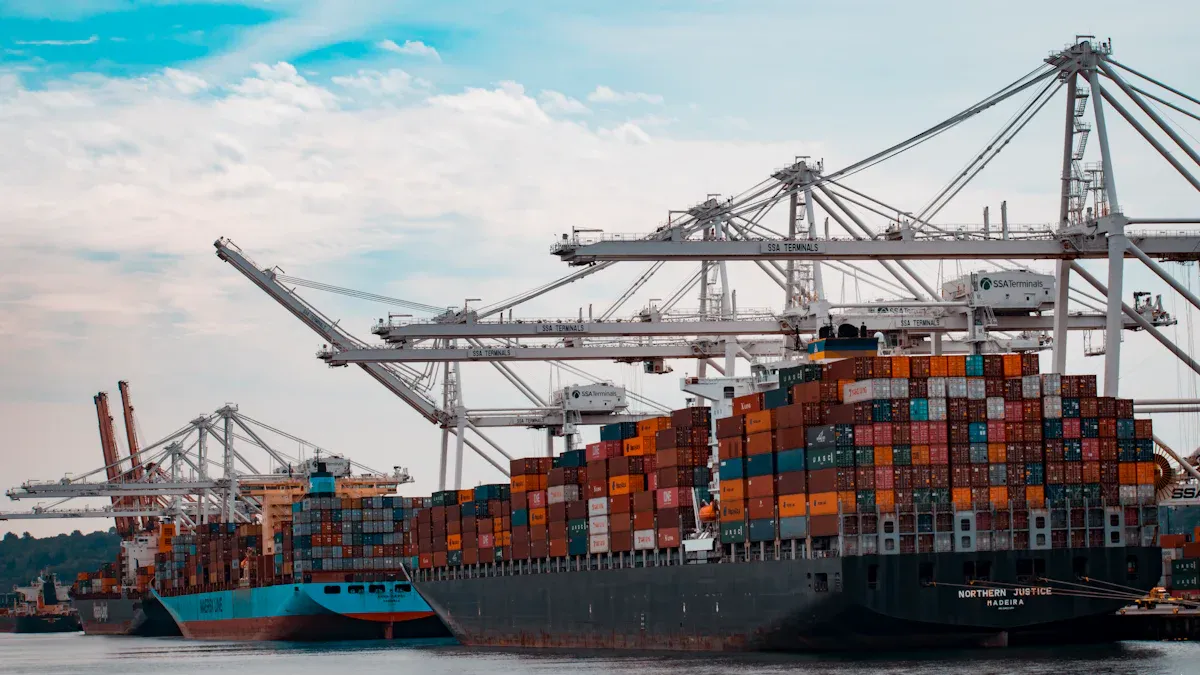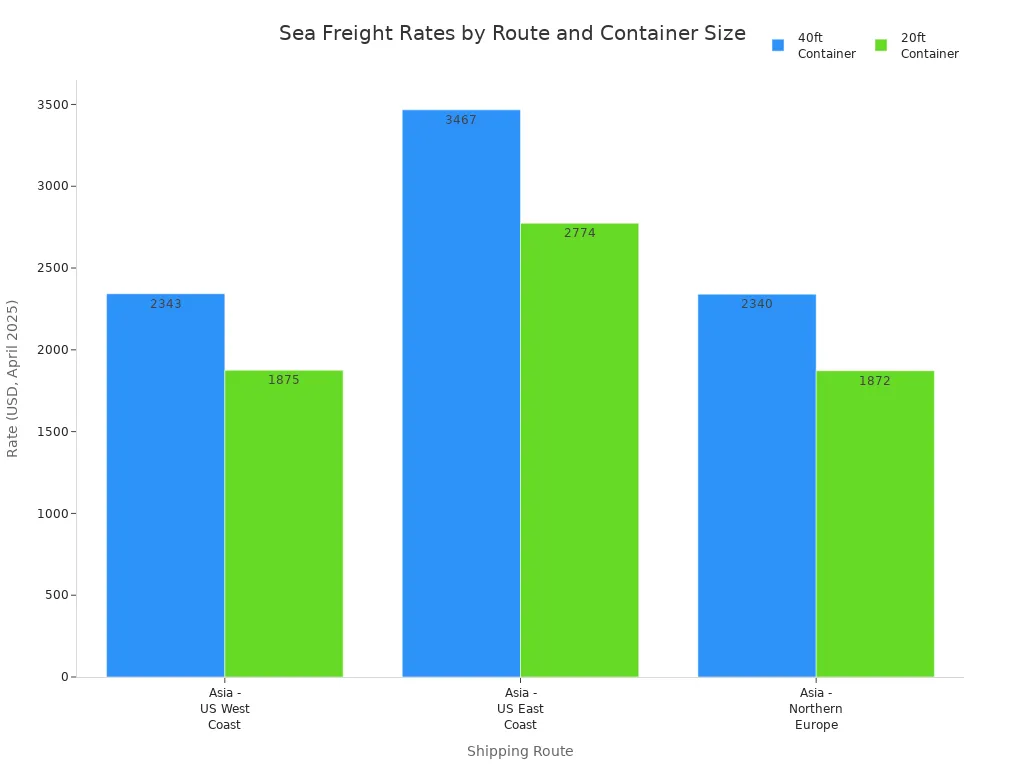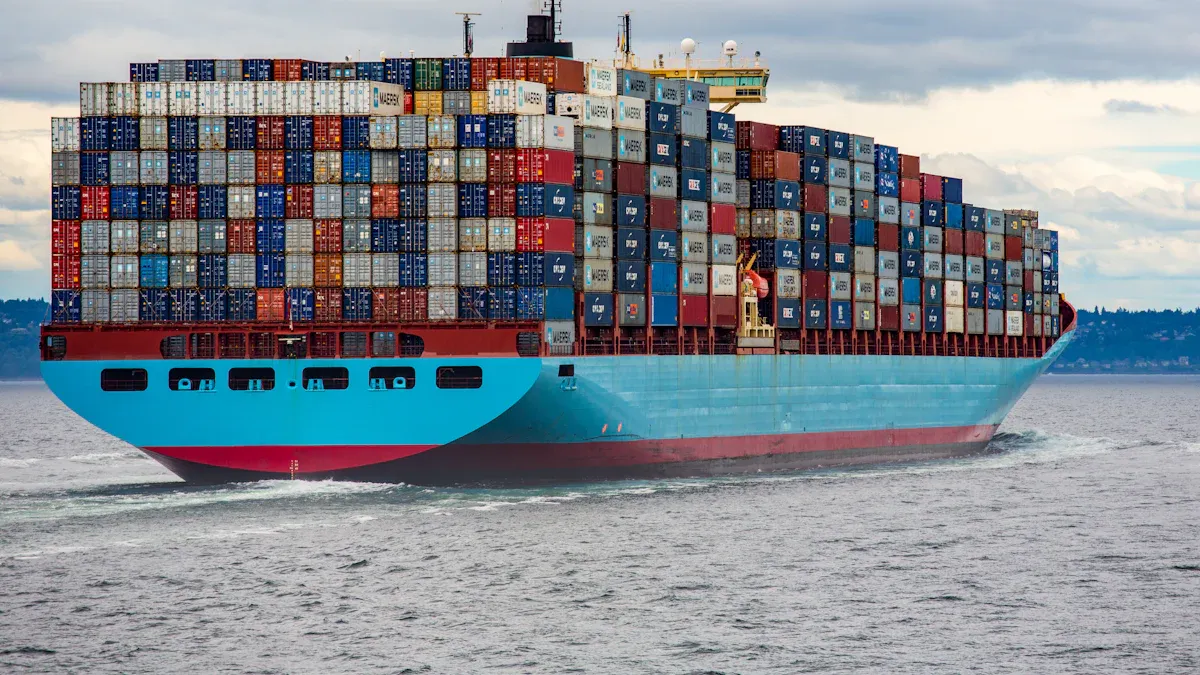

Views: 0 Author: Site Editor Publish Time: 2025-06-11 Origin: Site








Many companies want to know the current freight charges by sea. For instance, the average cost for a 20ft container from Shanghai to Los Angeles starts at $2,306. Ocean freight companies often present prices like this in tables:
Trade Lane | Freight Type | Average Rate (USD) | Transit Time (Days) |
|---|---|---|---|
Shanghai - Los Angeles | FCL 20' Container | From $2,306 | 33-45 |
Shanghai - Los Angeles | LCL 1 CBM | From $624 | 35-50 |
Freight charges by sea are a significant part of container shipping expenses. Understanding these shipping costs and average container shipping rates helps companies plan more effectively. Sea freight charges can fluctuate due to various factors. Dongguan Youda Freight Forwarding Ltd offers ocean freight services to assist with container shipping and reduce overall shipping costs.
Sea freight charges change by route, container size, and demand. 40ft containers usually cost less per unit than 20ft ones. Fuel prices, port fees, and extra surcharges can raise shipping costs fast. These costs can also change quickly. Planning shipments early helps save money. Comparing quotes from different companies is also smart. Picking the right container type can lower sea freight costs. Extra fees like paperwork, customs duties, and peak season surcharges add to the price. It is important to know about all possible charges. Using trusted freight forwarders and online tools makes shipping easier. They help control costs and stop surprise charges at the end.

Ocean freight plays a vital role in global trade. Over the past year, freight charges by sea have changed quickly. Many companies have seen shipping costs rise on major trade routes. Here is a summary of how global sea freight rates have shifted in the last 12 months:
Spot sea freight rates on routes from the Far East have increased by 100% to over 200% compared to last year.
Far East to North Europe rates went up by 198% year-over-year.
Far East to US West Coast rates rose by 214% year-over-year.
Far East to Mediterranean rates doubled, showing a 100% increase.
Far East to US East Coast rates increased by 129% year-over-year.
Long-term contract rates stayed mostly flat, while spot rates jumped.
These changes happened because of record demand, geopolitical tensions like the Red Sea crisis, port congestion, and shippers moving goods early to avoid delays.
The Containerized Freight Index showed a 52.83% year-over-year decline, showing how spot and contract prices can differ.
Many shippers now frontload imports to avoid risks, which pushes spot rates higher.
The Freightos Baltic Index (FBX) gives real-time data on ocean freight. The current global container freight index stands at $2,541.60, with a volatility of 1.4%. This means rates have some ups and downs but remain mostly stable. Transpacific routes have seen sliding rates, while Europe to South America West Coast saw a small increase of 1.83%. Europe to South America East Coast had a slight decrease of 1.2%. Geopolitical events, new ships, and changes in trade policies all affect these trends. The FBX expects global container volumes to grow by 3% by 2025. Despite some sliding rates, freight charges by sea remain a key part of shipping costs for businesses worldwide.
Freight rates depend on the route and the size of the container. Most companies use either a 20ft or 40ft container for ocean freight. The 40ft container holds about twice as much as a 20ft container, but it does not cost twice as much. This makes the 40ft container more cost-efficient for many shipments.
The table below shows average container shipping costs for major trade lanes as of April 2025:
Route | Container Size | Approximate Rate (April 2025) | Cost Relationship & Capacity |
|---|---|---|---|
Asia - US West Coast | 40ft (FEU) | $2,343 per FEU | 40ft container costs 20-25% more than 20ft but has double capacity |
Asia - US East Coast | 40ft (FEU) | $3,467 per FEU | Same cost efficiency applies as above |
Asia - Northern Europe | 40ft (FEU) | $2,340 per FEU | Same cost efficiency applies as above |
A 20ft container (TEU) has a capacity of about 1,172 cubic feet. A 40ft container (FEU) holds about 2,389 cubic feet. The 40ft container usually costs only 20-25% more than the 20ft, making it a better value for larger shipments. Freight charges by sea can change based on cargo type, how well the container is packed, and supply and demand.

Recent trends show that while some routes have seen slight decreases in sea freight rates, others remain steady or have small increases. Ocean freight costs also depend on factors like port congestion, labor strikes, and changes in global trade. Companies must watch these trends to manage container shipping expenses. Many businesses use ocean freight for both full container loads and less-than-container loads. Choosing the right container size and route can help lower shipping costs.
Note: Freight charges by sea can change quickly. Companies should check current rates before booking ocean freight. Using a reliable freight forwarder can help manage container shipping and keep shipping costs under control.
Fuel prices are very important for ocean freight. Shipping companies use the Bunker Adjustment Factor to handle fuel cost changes. If fuel prices go up, BAF surcharges also go up. This makes shipping more expensive for containers. The International Maritime Organization has rules for cleaner fuel. These rules make fuel cost more. Usually, fuel surcharges are about 13-14% of shipping costs on big trade lanes. Carriers set BAF rates based on their own costs and routes. These surcharges can change fast. Companies need to watch them to keep ocean freight costs low.
Port fees and local charges add to ocean freight costs. These include terminal handling charges, demurrage, detention, and storage. The amount depends on the port and container size. For example:
Port | 20ft THC (USD) | 40ft THC (USD) |
|---|---|---|
Shanghai | 150–200 | 250–300 |
Rotterdam | 220–275 | 330–385 |
Los Angeles | 300–400 | 400–500 |
Other local fees are for trucking, delivery, and destination agent services. Ports with better technology and lower labor costs, like Shanghai, have lower fees. Ports with higher labor and infrastructure costs, like Los Angeles, charge more. These fees can change with demand and local situations. This affects container shipping and total shipping costs.
The type and load of a container affect ocean freight rates. Full Container Load shipments have one price per container. Less than Container Load shipments are charged by volume or weight. LCL often costs more per unit because of extra handling and longer transit times. When a shipment is about 10-12 cubic meters, FCL is cheaper. Special containers, like open-top or refrigerated ones, have extra surcharges. Overweight cargo also costs more to ship. Picking the right container type helps companies control shipping expenses.
Market demand makes ocean freight rates go up or down. During busy times, like holidays or back-to-school, carriers add peak season surcharges. These surcharges raise shipping costs for containers. Events like the Red Sea crisis or new trade rules can disrupt supply chains. This can make rates rise quickly. When demand is low, rates usually drop. Companies can plan early, use different carriers, or work with freight forwarders to manage these changes. Recent supply chain problems, like ships going around the Cape of Good Hope, have made transit times longer and shipping costs higher. Geopolitical events, new rules, and port congestion also affect ocean freight rates.

Ocean freight costs have a few main parts. Companies pay a base rate to move goods between ports. Surcharges add more to this price. These can be for fuel, security, or busy seasons. Handling charges pay for loading and unloading at ports. Other costs can come from money changes or special services at the container station. Many companies also need extra help, like customs clearance, moving goods inland, cargo insurance, or last-mile delivery.
Dongguan Youda Freight Forwarding Ltd explains each part of container shipping costs. They offer both FCL and LCL shipping choices. Their team helps with booking, trucking, warehousing, and customs clearance. This support helps businesses keep ocean freight costs under control.
Extra fees can show up during container shipping. These depend on the route, cargo type, and where the goods go. The table below lists some common extra charges:
Charge Type | Description |
|---|---|
Documentation Fees | Paperwork for bills of lading and customs clearances. |
Terminal Handling Charges | Managing containers at ports, including loading and unloading. |
Customs Duties and Taxes | VAT, import tariffs, and other government fees. |
Demurrage and Detention Fees | Charges for containers held too long at or outside the port. |
Storage and Quarantine Fees | Fees for storage or health checks, especially for food or live animals. |
Peak Season Surcharges | Extra fees during busy shipping periods. |
Fuel Price-Based Surcharges | Charges that change with global fuel prices. |
Delivery Charges | Costs for moving goods from the port to the final address. |
Dongguan Youda Freight Forwarding Ltd helps manage these extra costs. Their services include DDP, customs clearance, and door-to-door delivery. This makes container shipping costs easier to predict.
Insurance and paperwork are important for safe and legal shipping. Insurance usually costs 0.5% to 1% of the cargo’s value. For example, insuring $10,000 worth of goods costs $50 to $100. Some shipping terms, like CIF, include insurance in the total cost. Others, like FOB, do not. Documentation fees pay for bills of lading and customs forms. Dongguan Youda Freight Forwarding Ltd helps with all paperwork and insurance. Their team makes sure every step of shipping meets legal and safety rules.
Tip: Always check if your quote includes insurance and paperwork. This helps you avoid surprises in the final shipping cost.
Online freight calculators make it easy to guess shipping costs. Tools like iContainers and SeaRates give quick price estimates for Full Container Load and Less than Container Load shipments. These calculators look at things like distance, container type, season, fuel prices, and port fees. They change their rates often to match the market. SeaRates also adds customs duties, insurance, and handling fees in its numbers. FreightCenter’s calculator uses data from carrier systems, so prices are more correct and mistakes are fewer. These tools show a clear list of container shipping costs, which helps with planning and comparing. But, people should know that final shipping costs might have extra fees not shown at first.
To get the right price for container shipping, shippers must give lots of details. Carriers and freight forwarders need to know product size, weight, and volume. They also ask about hazardous materials, how long the quote is good for, Incoterms, where the supplier is, port of loading, where the product is going, when the cargo is ready, and point pairs. This information makes sure shipping costs match what is really needed. Dongguan Youda Freight Forwarding Ltd helps clients collect these details for correct container shipping quotes. Giving the right info helps with planning and stops surprise shipping costs.
Required Information | Explanation |
|---|---|
Product size and weight | Needed for the right price and to stop extra charges or delays. |
Product volume | Shows if FCL or LCL is better and saves money. |
Hazardous material details | Needed to follow rules and avoid fines or cargo refusal. |
Validity dates | Shows how long the quote lasts; important because prices can change fast. |
Incoterms | Tells who pays for what between buyer and seller, which is key for contracts. |
Supplier location | Needed to know where goods start and for planning. |
Port of loading | Tells where the cargo enters the shipping system. |
Product destination | Helps plan the route and final delivery. |
Cargo ready date | Shows when the shipment can be picked up, which affects timing. |
Point pairs | Tells the start and end points for the best route and price. |
Looking at different container shipping providers helps businesses find good prices and service. Important things to check are sea freight rate, Bunker Adjustment Factor, ISPS fee, terminal handling charges, and haulage choices. It is also important to see clear cost lists and good service. Dongguan Youda Freight Forwarding Ltd gives clear prices and many container shipping services. Companies should check each provider’s experience, flexibility, and how well they control shipping costs. Using ideas like freight audits, better routes, combining loads, and using technology can lower shipping costs without hurting service. Picking the right partner helps make container shipping work well and keeps costs under control.
Tip: Always check freight quotes from a few providers to get the best deal for container shipping.
Sea freight charges go up and down for many reasons. The size of the shipment, the route, and fuel prices matter. Market demand also changes how much shipping costs. There are many hidden fees that can make container shipping more expensive. Shippers find it hard to guess shipping costs because fuel prices change a lot. Container shipping fees can also be confusing. To keep shipping costs low, companies should compare quotes from different providers. They can use online tools to help plan their shipments. Planning early helps avoid last-minute price increases. Companies can save money by putting shipments together. Picking flexible shipping times can also lower costs. Dongguan Youda Freight Forwarding Ltd gives expert help with container shipping. They support businesses at every step to keep shipping costs under control.
FCL stands for Full Container Load. One company uses the whole container. LCL means Less than Container Load. Many companies share one container. FCL is usually cheaper per item for big shipments.
A business should plan shipments early. They can combine cargo and pick flexible shipping dates. Comparing prices from different companies helps save money. Using a freight forwarder like Dongguan Youda Freight Forwarding Ltd can also help lower costs.
Sea freight rates change because fuel prices go up and down. Market demand and world events also make rates change. Port congestion and new rules can raise costs. Companies need to check rates often to avoid surprises.
Shippers need a bill of lading, a commercial invoice, and a packing list. Customs forms are also needed. Some shipments need extra certificates. Dongguan Youda Freight Forwarding Ltd helps get all the right documents ready.
Most sea freight prices do not include insurance. Shippers can buy insurance for more protection. Insurance usually costs 0.5% to 1% of the cargo’s value. > Tip: Always ask if insurance is part of your price quote.